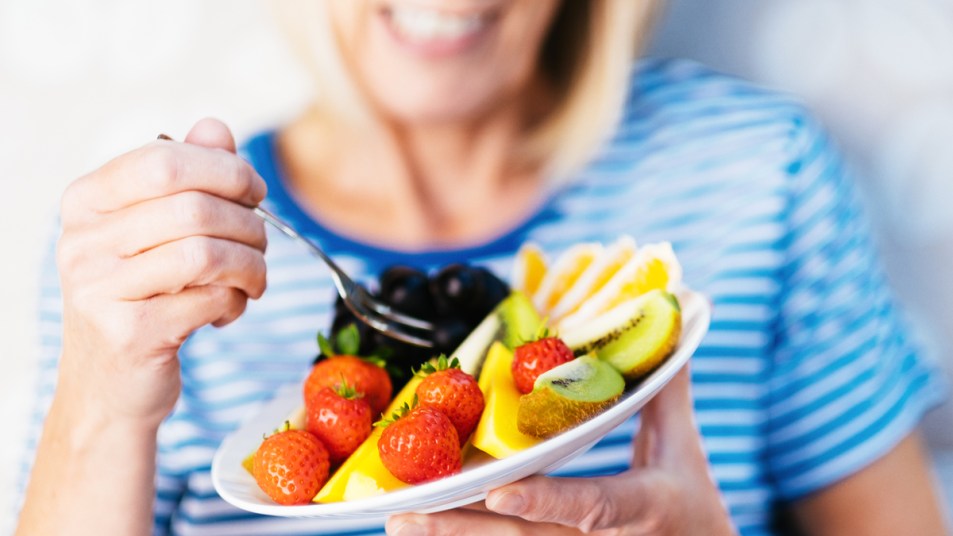5 Types of Food That Will Help You Lose Weight During Quarantine
Snack smart and slim down!

If you’re like most of the country under stay-at-home orders due to the coronavirus (COVID-19) crisis, you’re probably eating more ice cream, cookies, and chips than normal, and just eking out a workout here and there.
The result? Snug jeans and a scale that creeps up by the week. To lose a few pounds, you may be tempted to rule out entire food groups or majorly cut calories. That’s a no-no, says Eliza Kingsford, MA, LPC, NCC. “After teaching thousands of people how to maintain a healthy weight,” she says, “I know that restriction and taking foods away backfires.”
The numbers back her up. One study found that three years after concluding a diet, only 12 percent of those surveyed were able to keep off at least 75 percent of the weight they had lost. And a full 40 percent had gained more weight than they lost during the diet.
The key to weight loss, says Kingsford, is to focus on adding specific food categories into your diet to help shed pounds safely and effectively for the long-term.
Get Enough Lean Protein
“Protein helps keep you full,” says Kingsford. So filling your plate with lean protein increases satiety and means you’re less likely to attack the snack drawer a few hours after a meal. Egg-white omelettes and veggies or Greek yogurt with berries for breakfast, sliced turkey in a salad for lunch, and grilled fish or chicken with grilled vegetables for dinner are good options. If you’re not a meat- or dairy-eater, focus on legumes and tofu, and other soybean-derived proteins.
When it comes to snacks, avoid diving for a bag of chips and focus instead on what’s going to keep you full for the least number of calories. Protein can help you do this. An apple with low-fat cheese is a good option as is a portion of nuts like almonds. A serving of cottage cheese and fruit will also keep you from starving before dinner.
Focus On High-Fiber Foods
“Fiber is another key player in satiety and fullness,” says Kingsford. “It will help you stay full longer and feel more satisfied after eating.”
This is because fiber adds volume to your meal — it’s found in fruits, vegetables, and whole grains — and takes longer to digest, which keeps you full on less calories. For example, two cups of cooked zucchini noodles have just 34 calories, and two cups of cauliflower rice have 50 calories. Use either to replace pasta, then top with a turkey Bolognese and you’ve got a low-calorie, filling dinner.
Make More Soups and Salads
Vegetables are also the star of soups and salads, and eating one or the other before a meal can help offset hunger for the main – and often calorie-laden – event, especially if you are cooking one meal for the whole family.
“To drop pounds, eat a salad as the first course of a meal,” says Wendy Bazilian, DrPH, and author of Eat Clean, Stay Lean: The Diet ($9.40, Amazon). “Naturally low-cal and loaded with filling fiber, a healthy soup or salad is one of the most satisfying ways to amp nutrition while slashing calories.”
Soups should be broth-based to keep calories in check (creamy soups are often made with butter and dairy), and salads should include lots of crunchy vegetables and a scant amount of vinaigrette (again, avoid those creamy dressings.)
Don’t Avoid Fat
Say what? Yes, this is true. “You want high-quality fat from whole food sources,” says Kingsford. “Fat is the final key player in the satiety and fullness factor.”
This includes servings of monounsaturated and polyunsaturated fats, both of which can help reduce the risk of high blood cholesterol levels and help keep you full. A gram of fat contains nine calories, so you want to eat the following foods, but sparingly:
- Olive, peanut, and canola oils
- Avocados
- Nuts such as almonds, hazelnuts, and pecans
- Seeds such as pumpkin and sesame seeds
- Sunflower, corn, soybean, and flaxseed oils
- Walnuts
- Flax seeds
Go For Nutrient-Dense Whole Foods
Questioning whether that 100-calorie pretzel snack pack is a good idea? While the calories won’t derail you, the nutritional profile of processed foods like chips, pretzels and cookies will likely leave you hungrier than you’d be if you at a plateful of sliced vegetables and a serving of hummus, or a fruit smoothie.
“Fill your plate each meal with foods that are nutrient-dense and as close to their purest form as possible,” says Kingsford. “This means there is either no nutrition label or that you recognize all the ingredients — ideally very few ingredients to list — on the label.”












